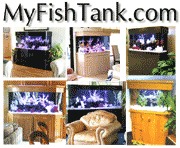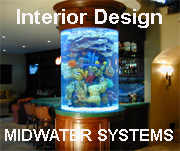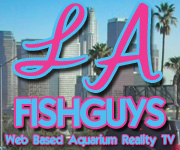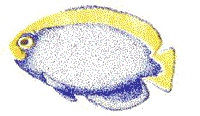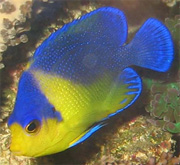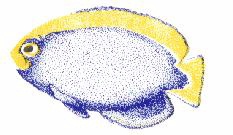|
A Bit of Aquarium History
The following article is a portion of a presentation that I gave
at the
Marine Ornamentals '99 conference in Kona, Hawaii, November 1999
The origins of aquarium keeping have been around for about as long as
keeping food fishes, although the methodology and understanding of aquarium
filtration has varied considerably. The origins of aquaculture mostlikely
originated when fish were trapped in some type of enclosure after monsoon
floods receded. Earliest records of fish farming come from China, where
hatching of carp was practiced in 2,000 BC.
During the mid 1800ís the " Balanced Aquarium " approach was considered
the only method for keeping aquarium fish.. The Balanced Aquarium consisted
of " a tank in which the air surface of the water, aided by plants would
supply sufficient oxygen " and " most of the waste from the fish was consumed
by the plants and scavengers ".
 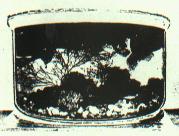 
During the early 1900ís Aeration, Particulate and Charcoal filtration
was touted as the state-of-the-art.......
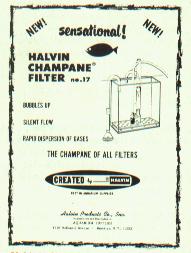 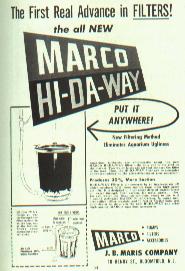
...but it wasnít until the 1950ís that the Undergravel Filter was introduced.
Ironically even though it was promoted as a biological filter its true
role in filtration was still misunderstood, and yet the Undergravel Filter
has been the greatest advancement to the aquarium industry.
 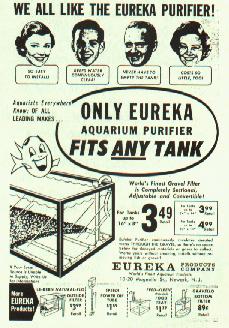
It wasnít until 1974 that successful commercial attempts to spawn and
rear marine ornamental fish began to occur and by 1975 Martin Moe and Chris
Turk of Aqualife Research and Frank Hoff and Tom Frakes of Instant Ocean
Hatcheries were raising three species of clownfish, Oscellaris (Amphiprion
ocellaris, ), the Tomato ( A.frenatus ) and the Clarki Clownfish ( A.clarkii.
).

By 1976 five more species of clownfish had been added to the list, and
as of today there are about 15 species of clownfish that have been successfully
bred.
In 1984 the second greatest advancement occurred in the aquarium industry,
the introduction to the US of the European Wet - Dry Filter. Now hobbyists
could keep fish as well as corals and invertebrates successfully.

The majority of corals kept at that time were large polyped stony corals,
soft and leather corals, xenia, as well as zooanthids and actinians.
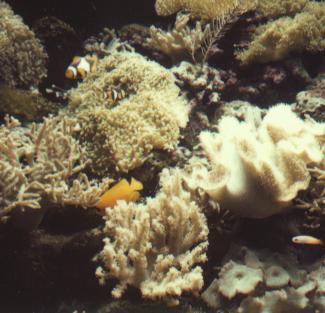 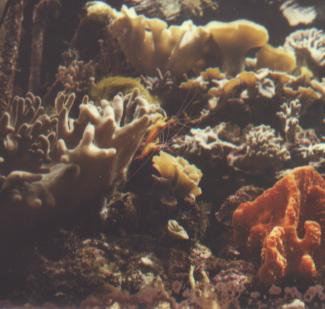
In, approximately, 1990 a greater number of Acropora species became
available. Many hobbyists became entranced with these fast growing small
polyped stony corals. Today SPS corals hold a greater appeal than the other
corals and the reason for it may be that they are much easier to fragment
and grow.
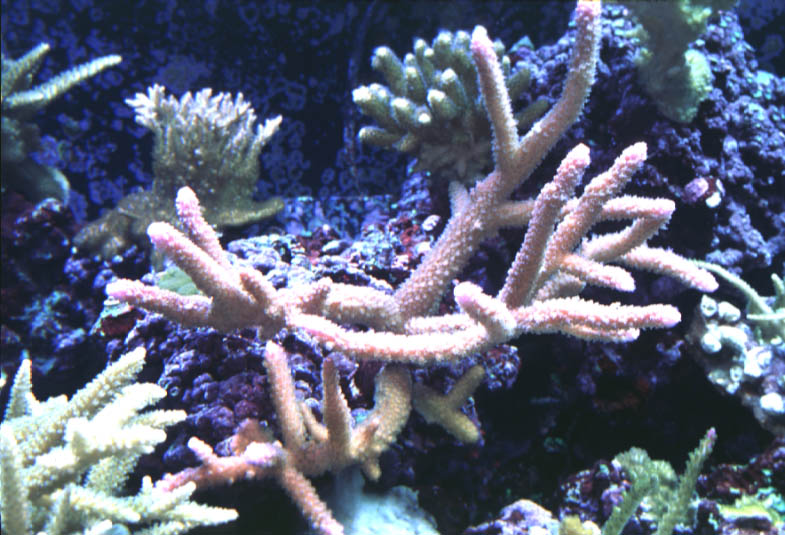 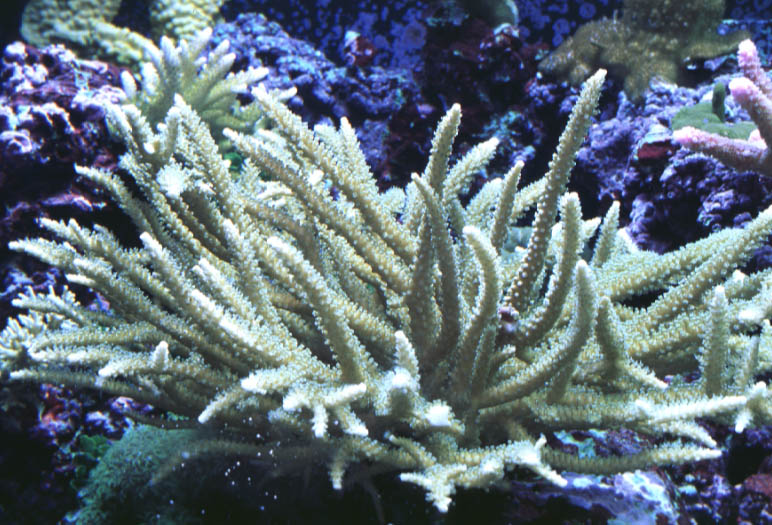
Today many hobbyists are beginning to propagate a wide variety of corals,
and a number of hobbyists are becoming successful at raising some marine
fish. This has lead to the beginnings of a new industry in Mariculture,
and yet there are less than a dozen commercial businesses and a scattering
of hobbyists currently involved in it.
So why is mariculture becoming a topic of interest these days ? Is this
the next step in marine aquarium keeping ? Is it due to articles such as
" Raiders of the Reefs " in Audobon Magazine, or " Corals in Peril " in
National Geographic, or " Reef Alert " in Aquarium Fish Magazine ?
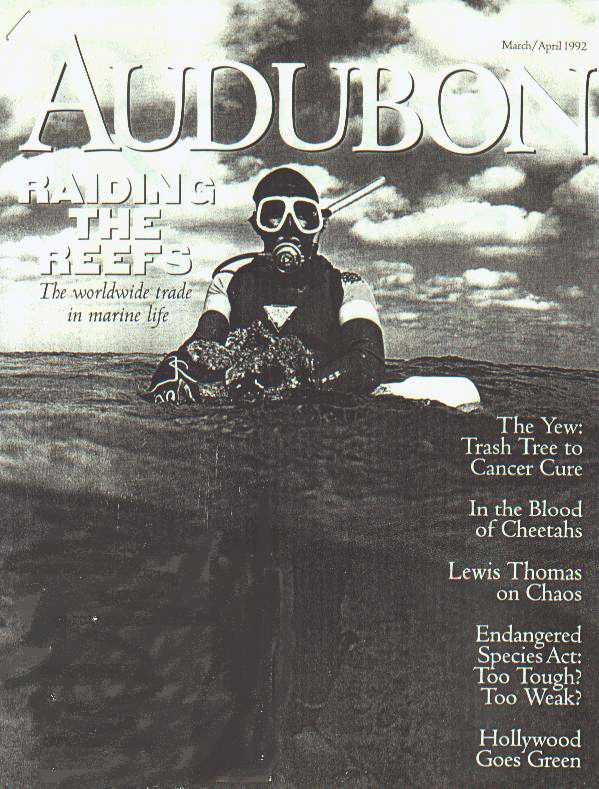 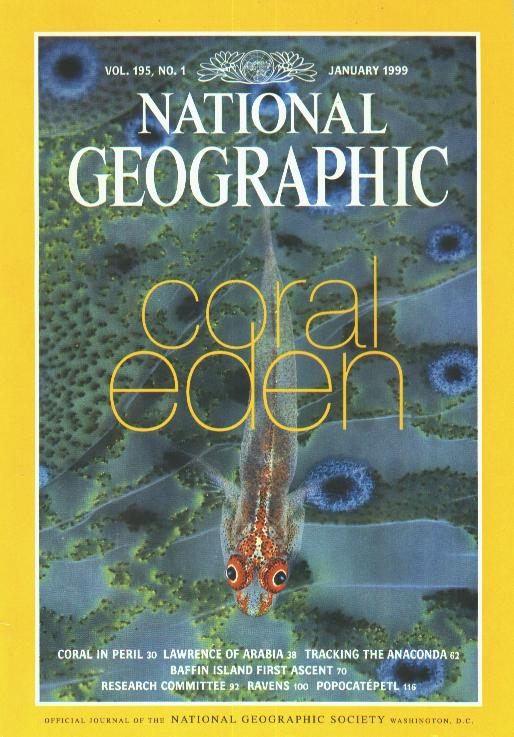 
Or is it the results of the June 11, 1998 CORAL REEF PROTECTION Executive
Order signed by President Clinton.

Its most likely a combination of all of these. The sad true is that
reports indicate that in 1998 sixty countries recorded coral bleaching
events due to global warming, over fishing and an assortment various pollution
factors. The results of these environmental and commercial conditions on
coral reefs have caused numerous Environmental Agencies to take notice
and to begin to question why and what can be done to minimize these effects.
Charles Delbeek recently attended a meeting of the Coral Reef Task Force,
part of President Clintons Executive Order, and wrote that one of the groups
involved, the International Working Group, " identified several key issues",
and at " The top of their list was the international trade in coral and
coral reef specimens"
So where does this leave the marine aquarium hobby ? With potential
restrictions on collection and importing of marine fish and invertebrates
mariculture, or tank raised specimens are a subject that needs to be explored
if wild caught aquarium habitants are going to decrease and the aquarium
hobby is to survive.
Currently there are approximately less than 60 species of marine aquarium
fishes being tank bred, most of which are the Clownfish species,
and less than 200 marine aquarium corals and invertebrates, most of which
are the Acropora and Soft Coral species, are being tank raised.
So who are marine hobbyist ? Hobbyists around the country seem to vary
quite a bit. They range from the teenager to semi-retired individuals.
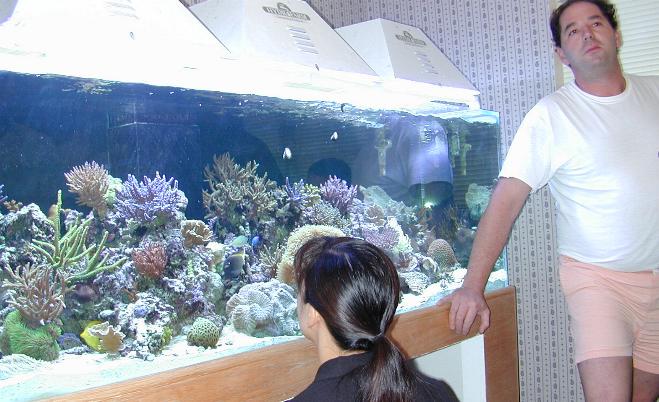
There are two different types of marine aquariums kept, the Fish Only....
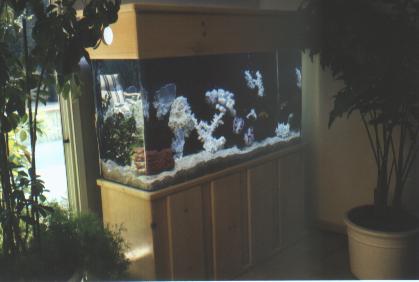 
.....and the Coral Reef tank.
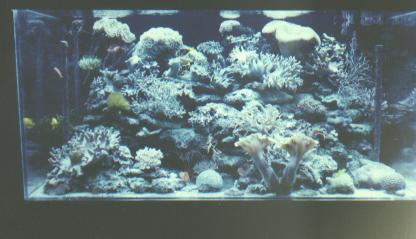 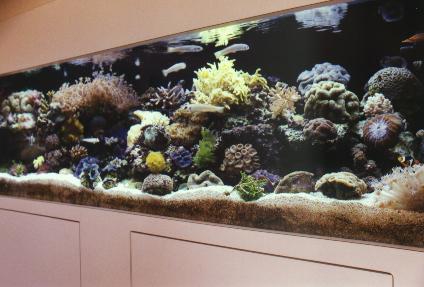
With Reef aquariums being the more involve and costly to set up, the
fish only system is generally where the hobbyist starts. Each of
those groups has three levels ; Beginner, Intermediate and Advanced.
The Beginning and Intermediate hobbyist are the ones who are the least
knowledgeable. They are the ones who will go all the shops in town, or
ask each sales clerk in each store what they think. Unfortunately the hobbyist
ends up totally confused as he now has numerous different versions as to
how to set up his tank. Sadly they are easy targets for over zealous sales
clerks who are not selling what the hobbyist needs but what the sales person
has in stock.
The Advanced hobbyist, having the advantage of past experience, may
spend more money overall but chances are that he does not spend it in the
same places as the other two levels of hobbyists.
There is a fourth level of hobbyist. That person is the one who hires
an Aquarium Service Company to set-up, stock, and or maintain the aquarium.
One may not actually consider this person a hobbyist but more so a viewer
of living furniture. Other than making the payments his only real involvement
is feeding the tank....and enjoying its beauty < s >.
As expected most beginning marine hobbyists have no real idea as to
what it takes physically, biologically or financially to start a marine
aquarium. Most assume that its a simple one-step, two-step, three-step
process A larger portion assume that its similar to owning a cat or a dog,
they just simply add water, add some food, and sit back and watch.
The Aquarium Hobby is the third largest segment of Pet Industry in the
United States. So why is there so much mis-information, mystique, and lack
of understanding ? Granted there are books, video tapes, magazines and
web sites. The sad truth is most of this information is never used by the
hobbyists, why ? I suspect itís partly due to the additional cost, and
partly due to the thought that operating an aquarium should be as simple
as owning a dog or a cat. Ironically the number of books on dog and cat
care is even less in the homes of pet owners. Think about it, how many
of you own a cat or a dog ? How many of you actually have information at
home on its care and keeping ?
My point is, other than sharing a some aquarium history, is that
most beginning marine hobbyists believe that they need to have a degree
in chemistry and marine biology...this is so untrue, but it will require
you to educate yourself in what it takes, on your part, to know what and
how to take proper care of a marine fish aquarium.
I wish to thank and credit the follow for being able to use thier
pictures ; FAMA Magazine, Advanced Aqua Tank, Martin Moe, Steve Tyree,
Audobon Magazine, National Geographic Magazine, Aquarium Fish Magazine,
The United States White House, Robert Becker, Bill Hawkins, Rusty West,
and John Dyer.
|
